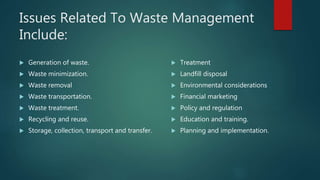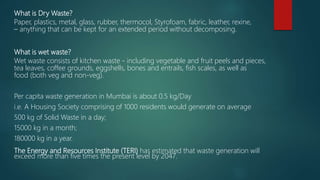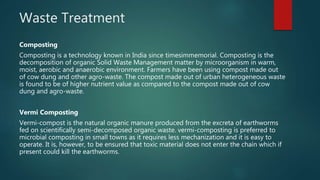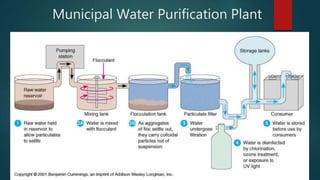Waste management
- 2. Issues Related To Waste Management Include: Generation of waste. Waste minimization. Waste removal Waste transportation. Waste treatment. Recycling and reuse. Storage, collection, transport and transfer. Treatment Landfill disposal Environmental considerations Financial marketing Policy and regulation Education and training. Planning and implementation.
- 3. Waste Segregation What do you mean by waste segregation? Waste segregation basically means keeping wet and dry wastes separately, so that dry can be recycled and wet waste can be composted. Why should I do it? So that it reduces waste that reaches landfills and reduces pollution to air and water So that different processes- composting, recycling, incineration can be applied to different kinds of waste
- 4. What is Dry Waste? Paper, plastics, metal, glass, rubber, thermocol, Styrofoam, fabric, leather, rexine, – anything that can be kept for an extended period without decomposing. What is wet waste? Wet waste consists of kitchen waste - including vegetable and fruit peels and pieces, tea leaves, coffee grounds, eggshells, bones and entrails, fish scales, as well as food (both veg and non-veg). Per capita waste generation in Mumbai is about 0.5 kg/Day i.e. A Housing Society comprising of 1000 residents would generate on average 500 kg of Solid Waste in a day; 15000 kg in a month; 180000 kg in a year. The Energy and Resources Institute (TERI) has estimated that waste generation will exceed more than five times the present level by 2047.
- 5. Methods Of Waste Segregation 1) Storage of Waste at Source The Solid waste is segregated at individual household level. The best and most efficient method if done correctly. Cheap and least time consuming. 2) Curbside Collection Scheme Waste Bins, Labeled and Color coded, are kept at regular intervals on streets. Each Bin is allotted for a particular type of category of recyclable waste Practiced in most Developed Cities. Cost Effective Method.
- 7. 3) Manual sorting Waste is collected and taken to a Segregation Plant. Waste is manually separated by Human Workforce. Still widely practiced. Time Consuming. 4) Automated Sorting Advanced Machinery is used to Separate Waste. Types: • Trommel separators/drum screens • Eddy current separator • Induction sorting • Near infrared sensors (NIR)
- 9. The basic collection option can be divided into: Primary Door to door using handcarts or tricycles Secondary From primary to trucks or tractor trolleys Dumping at designated location Shared container Block collection Kerbside collection Yard collection. Garbage: Collection.
- 10. Garbage: Collection and Disposal Recyclables Hazardous Bio-waste Organics Mixed
- 11. Recyclables Plastics Glass, Metal Paper, Cloth
- 13. Organics compost Bio-waste Mixed
- 14. IMPACTS OF WASTE IF NOT MANAGED WISELY •Affects our health •Affects our socio-economic conditions •Affects our coastal and marine environment •Affects our climate •GHGs are accumulating in Earth’s atmosphere as a result of human activities, causing global mean surface air temperature and subsurface ocean temperature to rise. •Rising global temperatures are expected to raise sea levels and change precipitation and other local climate conditions. •Changing regional climates could alter forests, crop yields, and water supplies. •This could also affect human health, animals, and many types of ecosystems. •Deserts might expand into existing rangelands, and features of some of our national parks might be permanently altered.
- 15. IMPACTS OF WASTE… - Some countries are expected to become warmer, although sulfates might limit warming in some areas. - Scientists are unable to determine which parts of those countries will become wetter or drier, but there is likely to be an overall trend toward increased precipitation and evaporation, more intense rainstorms, and drier soils. - Whether rainfall increases or decreases cannot be reliably projected for specific areas.
- 16. Impacts of waste…. Activities that have altered the chemical composition of the atmosphere: - Buildup of GHGs primarily carbon dioxide (CO2) methane (CH4), and nitrous oxide (N20). - C02 is released to the atmosphere by the burning of fossil fuels, wood and wood products, and solid waste. - CH4 is emitted from the decomposition of organic wastes in landfills, the raising of livestock, and the production and transport of coal, natural gas, and oil. - N02 is emitted during agricultural and industrial activities, as well as during combustion of solid waste and fossil fuels. In 1977, the US emitted about one-fifth of total global GHGs.
- 17. Waste hierarchy Waste hierarchy refers to 3 Rs Reduce, Reuse, Recycle
- 18. Waste Minimizing solid waste Minimizing packaging Recycleable Paper, plastics, metals, glass, wood Reusable ? Textiles, leather, rubber, metals, wood Compostable Yard trimmings, food scraps (vegetable)
- 19. Waste Treatment Composting Composting is a technology known in India since timesimmemorial. Composting is the decomposition of organic Solid Waste Management matter by microorganism in warm, moist, aerobic and anaerobic environment. Farmers have been using compost made out of cow dung and other agro-waste. The compost made out of urban heterogeneous waste is found to be of higher nutrient value as compared to the compost made out of cow dung and agro-waste. Vermi Composting Vermi-compost is the natural organic manure produced from the excreta of earthworms fed on scientifically semi-decomposed organic waste. vermi-composting is preferred to microbial composting in small towns as it requires less mechanization and it is easy to operate. It is, however, to be ensured that toxic material does not enter the chain which if present could kill the earthworms.
- 20. Incineration This method, commonly used in developed countries is most suitable for high calorific value waste with a large component of paper, plastic, packaging material, pathological wastes, etc. It can reduce waste volumes by over 90 per cent and convert waste to innocuous material, with energy recovery. The method is relatively hygienic, noiseless, and odorless, and land requirements are minimal. The plant can be located within city limits, reducing the cost of waste transportation. Sanitary Landfills and Landfill Gas Recovery Sanitary landfills are the ultimate means of disposal of all types of residual, residential, commercial and institutional waste as well as unutilized municipal solid waste from processing facilities and other types of inorganic waste and inerts that cannot be or recycled in the foreseeable future. Its main advantage is that it is the least cost option for waste disposal and has the potential for the recovery of landfill gas as a source of energy, with net environmental gains if organic wastes are landfilled. The gas after necessary cleaning, can be utilized power generation or as domestic fuel for direct thermal applications. Highly skilled personnel are not required to operate a sanitary landfill.
- 21. Major limitation of this method is the costly transportation of MSW to far away landfill sites. Down gradient surface water can be polluted by surface run-off in the absence of proper drainage systems and groundwater aquifers may get contaminated by polluted leacheate in the absence of a proper leacheate collection and treatment system. Recovery and Recycling Resource recovery is the process of taking useful discarded items for a specific next use. These discarded items are then processed to extract or recover materials and resources or convert them to energy in the form of useable heat, electricity or fuel. Recycling is the process of converting waste products into new products to prevent energy usage and consumption of fresh raw materials. Recycling is the third component of Reduce, Reuse and Recycle waste hierarchy. The idea behind recycling is to reduce energy usage, reduce volume of landfills, reduce air and water pollution, reduce greenhouse gas emissions and preserve natural resources for future use.
- 22. Waste to Energy (Recover Energy) Waste to energy(WtE) process involves converting of non-recyclable waste items into useable heat, electricity, or fuel through a variety of processes. This type of source of energy is a renewable energy source as non-recyclable waste can be used over and over again to create energy. It can also help to reduce carbon emissions by offsetting the need for energy from fossil sources. Waste-to-Energy, also widely recognized by its acronym WtE is the generation of energy in the form of heat or electricity from waste.
- 23. Wastewater Treatment Objectives Wastewater treatment systems take human and industrial liquid wastes and make them safe enough (from the public health perspective) to return to the aquatic or terrestrial environment. In some cases, wastewater can be clean enough for reuse for particular purposes. Wastewater treatment systems use the same processes of purification that would occur in a natural aquatic system only they do it faster and in a controlled situation. isis.csuhayward.edu/alss/Geography/ mlee/geog4350/4350c4f01.ppt
- 24. Wastewater Treatment Types of treatment systems include: Septic Tanks or Wastewater Treatment Plants (WWTPs). •Septic Tanks typically treat small volumes of waste (e.g., from a single household, small commercial/industral) •WWTPs typically treat larger volumes of municipal or industrial waste.
- 25. Septic Tanks • Approx. 22 million systems in operation ( 30% of US population) • Suitability determined by soil type, depth to water table, depth to bedrock and topography • Commonly fail due to poor soil drainage • Potential contaminants: bacteria, heavy metals, nutrients, synthetic organic chemicals (e.g. benzene)
- 26. Wastewater or sewage treatment is a multistep process: 1. Primary Treatment (Physical Process) Removal of large objects using grates and screens Settling to remove suspended solids (primary sludge) flocculating chemicals are added to enhance sedimentation 2.Secondary Treatment (Microbial Process) Supernatant or primary effluent contains high levels of dissolved organic load (Biological Oxygen Demand) Aeration to stimulate aerobic degradation activated sludge reactor trickling filter reactor
- 27. Sewage Treatment Tertiary Treatment (Physicochemical Process) Precipitation Filtration Chlorination Treated water is discharged to waterways Used for irrigation Recycled into drinking water expensive process, sharply reduces inorganic nutrients (PO4, NO3)
- 28. Overview of Wastewater Treatment Processes
- 29. Municipal Water Purification Plant
- 30. Discharge of sewage WHAT IS A SEWAGE? SEWAGE IS A WATER-CARRIED WASTE, IN SOLUTION OR SUSPENSION,THAT IS INTENDED TO BE REMOVED FROM A COMMUNITY. SOURCES OF SEWAGE • The wastewater generated from the household activities contributes to the major part of the sewage. • The wastewater generated from recreational activities , public utilities, commercial complexes ,and institutions is also discharged into sewers. • The wastewater discharged from small and medium scale industries situated within the municipal limits and discharging partially treated or untreated wastewater in to the sewers also contributes for municipal wastewater.

































